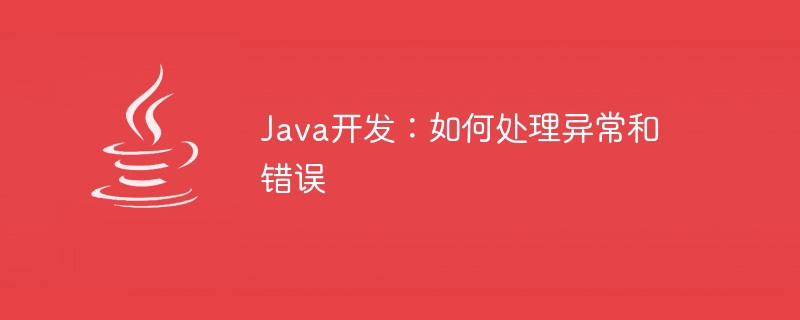Home >Java >javaTutorial >Java Development: How to Handle Exceptions and Errors
Java Development: How to Handle Exceptions and Errors
- WBOYWBOYWBOYWBOYWBOYWBOYWBOYWBOYWBOYWBOYWBOYWBOYWBOriginal
- 2023-09-20 14:27:19851browse

Java Development: How to Handle Exceptions and Errors
In the Java development process, exceptions and errors are inevitable. However, reasonable handling of exceptions and errors is an important part of ensuring program quality. This article will combine detailed code examples to introduce how to handle exceptions and errors in Java development.
- The concept and difference between exceptions and errors
In Java, exceptions (Exception) refer to abnormal situations when the program is running, such as array out-of-bounds, null pointer reference, etc. . Exceptions can be caught and handled. Error refers to a situation that cannot be recovered or handled, such as memory overflow, system crash, etc. Errors are usually uncontrollable and cannot be handled by code, and usually require the help of the operating system or other external means.
- Basic principles of exception handling
(1) Throw exceptions clearly
When exceptions may occur in a method, exceptions should be thrown explicitly. Use the throws keyword in a method declaration to indicate the types of exceptions that the method may throw. For example:
public void readFile() throws FileNotFoundException {
// 读取文件的代码
}(2) Catching exceptions
When calling a method that may throw an exception, you should use the try-catch statement to capture the exception and handle it appropriately. For example:
try {
readFile();
} catch (FileNotFoundException e) {
// 处理文件未找到异常的代码
}(3) Handling exceptions
For the caught exceptions, you can choose to process them, such as printing error information, performing business logic processing, returning default values, etc. For example:
try {
readFile();
} catch (FileNotFoundException e) {
System.out.println("文件未找到");
// 其他处理逻辑
}(4) Throw an exception
When an exception is caught but cannot be handled, you can choose to throw the exception again and let the upper layer method handle it. Use the throw keyword to throw exceptions. For example:
public void readFile() throws FileNotFoundException {
try {
// 读取文件的代码
} catch (FileNotFoundException e) {
throw e;
}
}- Sample code for exception handling
The following is a simple example to illustrate the specific method of exception handling. Suppose there is a calculator class Calculator, which has a division operation divide(). When the divisor is 0, a custom exception DivisorIsZeroException needs to be thrown. The code is as follows:
public class DivisorIsZeroException extends Exception {
public DivisorIsZeroException(String message) {
super(message);
}
}
public class Calculator {
public double divide(double dividend, double divisor) throws DivisorIsZeroException {
if (divisor == 0) {
throw new DivisorIsZeroException("除数不能为0");
}
return dividend / divisor;
}
}
public class Main {
public static void main(String[] args) {
Calculator calculator = new Calculator();
try {
double result = calculator.divide(10, 0);
System.out.println("计算结果:" + result);
} catch (DivisorIsZeroException e) {
System.out.println("除数为0异常:" + e.getMessage());
}
}
}The running results are as follows:
除数为0异常:除数不能为0
The above example code creates a custom exception class DivisorIsZeroException and throws the exception in the Calculator's divide() method. In the main function, the exception is caught and handled through the try-catch statement.
Through the above code examples, we can see the specific steps and methods of exception handling. Reasonable handling of exceptions can not only improve the stability and reliability of the program, but also provide users with friendly prompt information and improve the user experience.
To sum up, reasonable handling of exceptions and errors is an important part of Java development. By clarifying the four steps of throwing exceptions, catching and handling exceptions, throwing exceptions, and handling exceptions, we can effectively control the program flow and improve the stability of the program. At the same time, by customizing exception classes, we can also customize exception types according to actual business needs and provide more friendly exception prompt information.
Therefore, meticulous exception handling capabilities are one of the essential skills for every Java developer.
The above is the detailed content of Java Development: How to Handle Exceptions and Errors. For more information, please follow other related articles on the PHP Chinese website!
Related articles
See more- Detailed explanation of Spring Boot global exception handling examples in java
- JAVA development of springBoot2.0 to build dual data sources
- Detailed introduction to exception types and exception handling in java
- Error handling methods in golang
- What are the four commonly used frameworks for java development?

